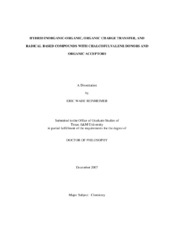| dc.description.abstract | The primary focus of this dissertation is the electrochemical preparation of radical
cation salts utilizing the donor o-4,4’-dimethyltetrathiafulvalene (o-Me2TTF) and
spherical, tetrahedral, octahedral, bimetallic, cyanometallate, and polyoxometallate
anions. Other donors, such as tetramethyl(tetraselenafulvalene) (TMTSF),
tetramethyl(tetrathiafulvalene) (TMTTF), bis(ethylenedithio)tetrathiafulvalene (BEDTTTF
or ET), and bis(propylenedithio)tetrathiafulvalene (BPDT-TTF or PT) also found
use in the preparation of salts in the course of this study. X-ray structural
characterization of these salts revealed stacking between donor molecules containing
significant S•••S interactions in the solid state. Various salts were subjected to either
conductivity or molecular magnetism measurements in order to determine the level of
itinerant electron density and magnetic contribution from paramagnetic charge
compensating anions. In order to expand the library of TTF-containing hybrid materials
prepared through metathesis, salts of other tetrathiafulvalenium radicals have also been
prepared and characterized crystallographically and by select spectroscopic methods. In an effort to gain further information on formation of organic charge transfer
complexes, TTF was combined with nitrofluorenone family of acceptors as well as the
organocyanide acceptors HAT-(CN)6 (HAT-(CN)6 = 1,4,5,8,9,12-hexaazatriphenylenehexacarbonitrile)
and TCNB (TCNB = 1,2,4,5-tetracyanobenzene). The complexes were
characterized using X-ray crystallography, infrared spectroscopy, and molecular
magnetism. All of these techniques showed that all compounds underwent little to no
charge transfer.
Commencing in 2003, the combined work of Dunbar and Omary revealed that
systems combining inorganic donors with chelating, sulfur-based ligands and organic
acceptors could have their spectroscopic response tuned to display low-energy charge
transfer bands extending into the near-IR making them suitable candidates as
photosensitizing dyes for semiconductors. In keeping with this idea, new layered charge
transfer compounds combining the nitrofluorenone family of acceptors and the inorganic
donor Pt(dbbpy)(tdt) (tdt = 3,4-toluenedithiolate) were prepared. The resulting
complexes were characterized utilizing X-ray crystallography as well as both
spectroscopic and electrochemical methods. Similar analyses were also conducted on
various platinum/terpyridine salts and illustrated a level of spectroscopic tunability to that
observed for the supramolcular systems composed of inorganic donors and organic
acceptors. | en |


